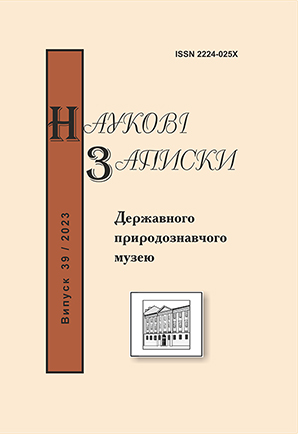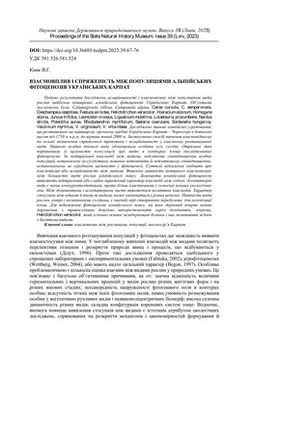Kyyak V.H.
Mutual influence and conjugation between populations of alpine phytocoenoses in the Ukrainian Carpathians // Proc. of the State Nat. Hist. Mus. - Lviv, 2023. - 39. - P. 67-76 DOI: https://doi.org/10.36885/nzdpm.2023.39.67-76 Key words: mutual influence between plants, populations, highlands of the Carpathians The results of studies of association and mutual influence between populations of plant species of the most common alpine phytocenoses in the Ukrainian Carpathians are shown in this work. Considering objects of the research such species have been taken into account: Calamagrostis villosa, Campanula alpinа, Carex curvula, C. sempervirens, Deschampsia cespitosa, Festuca airoides, Helictotrichon versicolor, Hieracium alpinum, Homogyne alpina, Juncus trifidus, Leontodon croceus, Ligusticum mutellina, Loiseleuria procumbens, Nardus stricta, Potentilla aurea, Rhododendron myrtifolium, Sesleria coerulans, Soldanella hungarica, Vaccinium myrtillus, V. uliginosum, V. vitisidaea. Typical alpine groups, which are located in the highest mountain range of the Ukrainian Carpathians - Chornohora in the range of altitude from 1750 m above sea level to peaks over 2000 m, have been researched in this work. The method of studying interactions based on the definition of conjugate occurrence and association in the mutual arrangement of species is applied. All neighboring individuals have been counted around individuals of the active species. The obtained data has been compared with the population density of these species in the contours of the studied phytocenosis area. If neutral interactions between species is considered, then the percentage ratio of individuals in populations, established by the neighborhood, should correspond to their percentage the ratio established by the average density in the phytocenosis. Significant deviations indicate mutual influence or association between species The existence of active interaction between most plant species of the alpine zone was found. Dominants of alpine phytocenosis express neutral or weak interaction among themselves. Asectatory species are less competitive, but more flexible in terms of occupying free ecological niches. A negative interaction is often found between dominants and asectators. The nature of the interaction between the same species can vary in different coenoses. In most cases the presence of plant species, which are considered as positive neighbors, creates prerequisites for colonization of areas. In addition to dominants, it is advisable to use Helictotrichon versicolor in particular, which successfully occupies unsown areas and has a positive interaction with many plant species, in order to restore phytocenoses of the alpine belt, where the turf cover has been disturbed.
Mutual influence and conjugation between populations of alpine phytocoenoses in the Ukrainian Carpathians // Proc. of the State Nat. Hist. Mus. - Lviv, 2023. - 39. - P. 67-76 DOI: https://doi.org/10.36885/nzdpm.2023.39.67-76 Key words: mutual influence between plants, populations, highlands of the Carpathians The results of studies of association and mutual influence between populations of plant species of the most common alpine phytocenoses in the Ukrainian Carpathians are shown in this work. Considering objects of the research such species have been taken into account: Calamagrostis villosa, Campanula alpinа, Carex curvula, C. sempervirens, Deschampsia cespitosa, Festuca airoides, Helictotrichon versicolor, Hieracium alpinum, Homogyne alpina, Juncus trifidus, Leontodon croceus, Ligusticum mutellina, Loiseleuria procumbens, Nardus stricta, Potentilla aurea, Rhododendron myrtifolium, Sesleria coerulans, Soldanella hungarica, Vaccinium myrtillus, V. uliginosum, V. vitisidaea. Typical alpine groups, which are located in the highest mountain range of the Ukrainian Carpathians - Chornohora in the range of altitude from 1750 m above sea level to peaks over 2000 m, have been researched in this work. The method of studying interactions based on the definition of conjugate occurrence and association in the mutual arrangement of species is applied. All neighboring individuals have been counted around individuals of the active species. The obtained data has been compared with the population density of these species in the contours of the studied phytocenosis area. If neutral interactions between species is considered, then the percentage ratio of individuals in populations, established by the neighborhood, should correspond to their percentage the ratio established by the average density in the phytocenosis. Significant deviations indicate mutual influence or association between species The existence of active interaction between most plant species of the alpine zone was found. Dominants of alpine phytocenosis express neutral or weak interaction among themselves. Asectatory species are less competitive, but more flexible in terms of occupying free ecological niches. A negative interaction is often found between dominants and asectators. The nature of the interaction between the same species can vary in different coenoses. In most cases the presence of plant species, which are considered as positive neighbors, creates prerequisites for colonization of areas. In addition to dominants, it is advisable to use Helictotrichon versicolor in particular, which successfully occupies unsown areas and has a positive interaction with many plant species, in order to restore phytocenoses of the alpine belt, where the turf cover has been disturbed.
References
- Динамика ценопопуляций растений. 1985. М. : Наука. 207 с.
- Дідух Я.П. 1998. Популяційна екологія. К. : Фітосоціоцентр. 192 с.
- Злобин Ю.А., Скляр В.Г., Клименко А.А. 2013. Популяции редких видов растений: теоретические основы и методика изучения. Сумы : Университетская книга. 49 с.
- Кияк В.Г. 1993. Метод визначення взаємовпливу та асоцiйованостi мiж видами. Укр. ботан. журн. Т. 50 № 1. С. 37–40.
- Кияк В.Г. 2007. Особливості сусідства, асоційованості та взаємовпливу між популяціями рідкісних видів рослин у високогір’ї Карпат. Наукові записки Державного природознавчого музею. Вип. 23. С. 31–42.
- Кияк В.Г. 2008. Методичні аспекти дослідження малих популяцій рідкісних видів рослин високогір’я Карпат. Науковий вісник Волинського національного університету імені Лесі Українки. Біологічні науки. № 3. С. 298–303.
- Кияк В.Г. 2013. Малі популяції рідкісних видів рослин високогір’я Українських Карпат. Львів : Ліга-Прес. 248 с.
- Куркин К.А. 1998. Взаимоотношения растений в луговых фитоценозах: особенности, типы, механизмы. Экология. № 6. С. 419–423.
- Работнов Т.А. 1992. Взаимоотношения между растениями в фитоценозах. Бюл. Моск. о-ва испытат. природы. Отд. биол. Т. 97. Вып. 2. С. 104–110.
- Begon M. 1997. Populationsoekologie. Heidelberg, Berlin, Oxford : Spektrum, Akad. Verl. 367 s.
- Callaway R. M., R W Brooker, P. Choler, Z. Kikvidze, C. J. Lortie, R. Michalet, L. Paolini, F. I. Pugnaire, B. Newingham, E. T Aschehoug, C. Armas, D. Kikodze, B. J Cook. 2002. Positive interactions among alpine plants increase with stress. Nature. Vol. 417. Р. 844–848.
- Cavieres L.A., Brooker R.W., Butterfield B.J., Cook B.J., Kikvidze Z., Lortie C.J., Michalet R., Pugnaire F.I., Schöb C., Xiao S., Anthelme F., Björk R.G., Dickinson K.J.M., Cranston B.H., Gavilán R., Gutiérrez-Girón A., Kanka R., Maalouf J.-P., Mark A.F., Noroozi J., Parajuli R., Phoenix G.K., Reid A.M., Ridenour W.M., Rixen C., Wipf S., Zhao L., Escudero A., Zaitchik B.F., Lingua E., Aschehoug E.T., Callaway R.M. 2014. Facilitative plant interactions and climate simultaneously drive alpine plant diversity. Ecol. Lett. Vol. 17. Р. 193–202.
- Chesson P. 2000. Mechanisms of maintenance of species diversity. Annu. Rev. Ecol. Syst. Vol. 31. Р. 343–366.
- Chu C.-J., Maestre F.T., Xiao S., Weiner J., Wang Y., Duan Z., Wang G. 2008. Balance between facilitation and resource competition determines biomass–density relationships in plant populations. Ecol. Lett. Vol. 11. Р. 1189–1197.
- Falińska K. 2002. Przewodnik do badań biologii populacji roślin. Warszawa : Wyd-wo Naukowe PWN. 579 s.
- Fischer М. 1998. Über die Ursachen der Gefährdung lokaler Pflanzenpopulationen. Bauhinia. Vol. 12 (1/2). S. 9–21.
- He Q., Bertness M.D. & Altieri A.H. 2013. Global shifts towards positive species interactions with increasing environmental stress. Ecol. Lett. Vol. 16. Р. 695–706.
- Kyyak V. 2004. Dispersal of Plants in Remote Arctic-Alpine Habitats. Modes and Time-Scales for Colonization. In: S.Skreslet (ed.), Jan Mayen Island in Scientific Focus. Kluwer Academic Publishers. Printed in the Netherland. Р. 195–206.
- Urbanska K.M. 1997. Restoration ecology research above the timberline: colonization of safety islands on a machine-graded alpine ski run. Biodiversity and Conservation. No 6. Р. 1655–1670.
- Wettberg E.J., Weiner J. 2004. Effects of distance to crop rows and to conspecific neighbours on the size of Brassica napus and Veronica persica weeds. Basic Appl. Ecol. No 5. S. 35–41.
- Zhang R., Tielbörger K. 2020. Density-dependence tips the change of plant–plant interactions under environmental stress. Nat Commun. Vol. 11., 2532. Р. 77–89.


